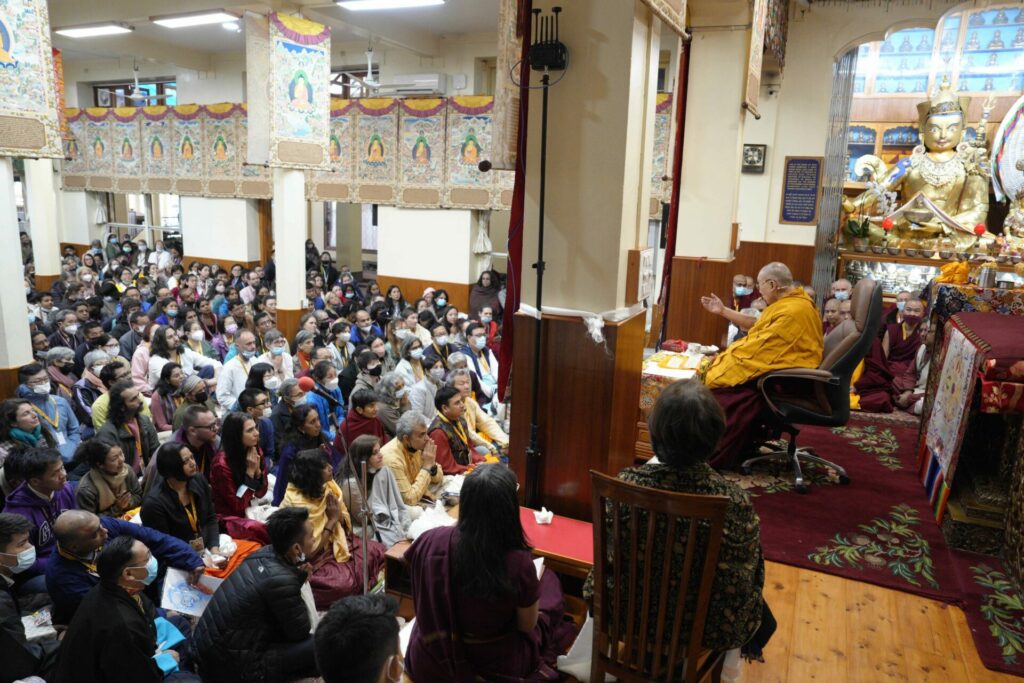A great global educationalist
By Cathy Evans
“My wish is that one day, formal education will pay attention to the education of the heart, teaching love, compassion, justice, forgiveness, mindfulness, tolerance, and peace”.
“Intolerance leads to hatred and division. Our children should grow up with the idea that dialogue, not violence, is the best and most practical way to solve conflicts. But this can become reality only if we educate, not just the brain, but also the heart.”
~ His Holiness the 14th Dalai Lama
His Holiness the Dalai Lama has been an exemplary role model in his educational attainments, his generosity in delivering ancient Buddhist teachings, his promotion of educational initiatives to advance Buddhism, and his promotion of the importance of human values in education.
Education in Tibet
His Holiness received his own education in Tibet. The formal curriculum, derived from the Indian Nalanda tradition, consisted of five major and five minor subjects. Emphasis was given to Buddhist philosophy and the study of the five great texts: Prajnaparamita, the perfection of wisdom; Madhyamika, the philosophy of the middle Way; Vinaya, the canon of monastic discipline; Abhidharma, metaphysics; and Pramana, logic, and epistemology.
In 1959 at age 23, His Holiness sat for his final examination in Lhasa’s Jokhang Temple. He passed with honours and was awarded the Geshe Lharampa degree, equivalent to the highest doctorate in Buddhist philosophy.
Educational initiatives in India
Arriving as a refugee in India in 1959, having just lost his country, His Holiness initiated and supported many educational initiatives.
The creation of the Tibetan Children Villages was instrumental in successfully educating thousands of Tibetan children who were refugees, orphans, poor, or whose parents were no longer able to care for them. The children were given a modern education, introduced to Tibetan culture as well as given a home.
In reforming and expanding monastic curricula, His Holiness initiated a general education for young monastics where they learn not only traditional Dharma topics, but also science, geography, social studies, and various languages.
He also encouraged Tibetan Buddhists to be non-sectarian and receive teachings from all four Tibetan Buddhist traditions with the aim of improving people’s Dharma knowledge, as well as nurturing harmony among the various lineages.
In Tibet, monastic education was only for monks but since the reforms of the 14th Dalai Lama, Gelug nuns are following this course of study with some now Geshemas.

His Holiness the Dalai Lama teaching from Lama Tsong Khapa’s text on Dependant Arising.*
Under the Dalai Lama’s leadership many Tibetan cultural institutions opened in India, for example, the Library of Tibetan Works and Archives. At the Library, a rich variety of activities take place including English Dharma classes, Tibetan language classes, a one-year diploma course and a two-year masters’ program in Buddhist studies, a museum, science studies and laboratories, and short courses in IT and digital security. The Library also hosts symposiums for teachers, education conferences, and a variety of other educational opportunities for both Tibetans and foreigners.
In addition to the Library, other new cultural institutions include the Dalai Lama Institute for Higher Education in Bengaluru, the Nalanda University in Rajgjr, the Dalai Lama Chair for Nalanda Studies at Goa University, and several chairs and departments dealing with Tibetan Buddhism and culture in western universities.
The Dalai Lama and Science
The Dalai Lama describes himself as: “My body, this person, half Buddhist monk, half scientist.” Since the mid-1980s, His Holiness has engaged in discussions with modern scientists, mainly in the fields of psychology, neurobiology, quantum physics and cosmology at his residence in India and at institutions abroad.
Under the Dalai Lama’s direction there has been an increase in science education among the older monks and nuns, with some recently attending science studies at Emory University in the USA.
A busy international teaching schedule
The Dalai Lama has tirelessly travelled the world giving teachings to large Buddhist audiences, usually based on classical Buddhist texts and commentaries, such as those written by the 17 pandits or the great masters of the Nalanda tradition. These erudite teachings are delivered in the inspiring style of an Indian Pandit.

The Dalai Lama giving a teaching in June 2023 to Indian and other philosophy student’s from around the world in the Namgyal temple, McLeod Ganj.*
Revival of Indian philosophy
More recently, His Holiness has lent his support to encouraging ancient Indian Buddhist knowledge among Indians today. International Buddhist organisations have developed masters’ programs for those interested in furthering their knowledge of Buddhist philosophy.
For example, many students of Tibet House New Delhi, recently graduated from a six-year Master’s Course in Nalanda Buddhist Philosophy, and hundreds of others completed a year-long diploma in Buddhist studies. At venues across the world, including our own, His Holiness has repeated his wish that all Buddhists place more effort into studying Buddhism.
With gratitude to His Holiness for his innumerable activities we offer prayers that his life is long, and he continues to inspire people of all nations across the world.
*Images from the website of the Office of His Holiness Dalai Lama.
